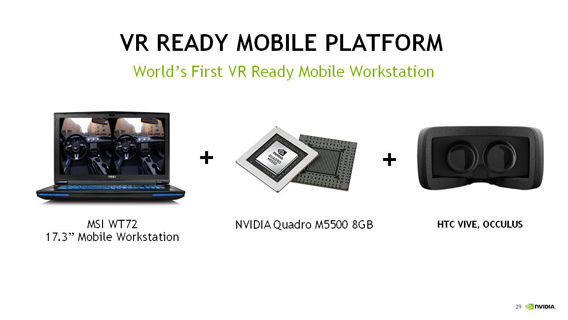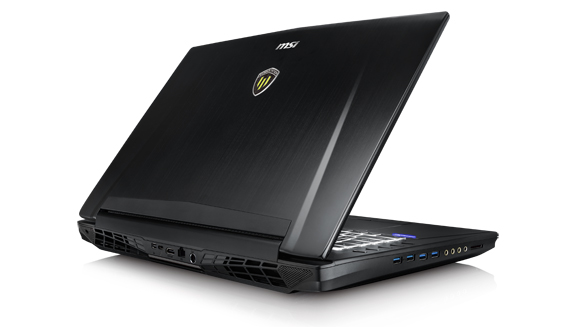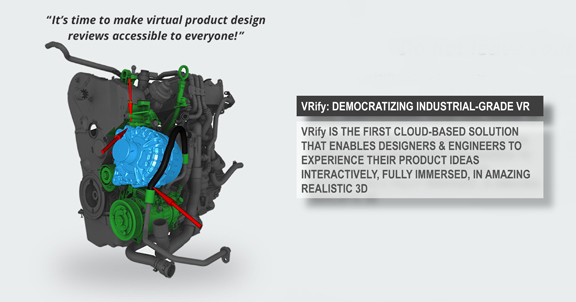
NVIDIA announces its VR-Ready program during the week of its annual GPU Technology Conference. (Image courtesy of NVIDIA)
April 4, 2016
 NVIDIA announces the NVIDIA VR-Ready program during the week of its annual GPU Technology Conference. (Image courtesy of NVIDIA)
NVIDIA announces the NVIDIA VR-Ready program during the week of its annual GPU Technology Conference. (Image courtesy of NVIDIA)Under the blue California sky, the San Jose McEnery Convention Center is once more decked out in logos and banners bearing a distinct shade of green—the NVIDIA green. The annual NVIDIA GPU Technology Conference (GTC) is set to kick off tomorrow. Today, the crowd that relies on the GPU for visualization and computing—game developers, digital artists, university researchers, architects, designers, and engineers—began streaming into the venue to pick up their badges, scout out good WiFi hot spots, and renew old acquaintances.
The show floor is currently off-limit to attendees, but early words from NVIDIA offer a clue to the kind of high-tech razzle-dazzle that awaits behind the curtain, in the partially-constructed booths.
“Virtual reality (VR) isn’t just at the heart of a new era of entertainment. It’s also for serious business,” the host of GTC wrote in a blog post. “That’s why we’re helping developers, businesses, OEMs and independent software vendors with our NVIDIA VR Ready program.”
VR-Capable Hardware
To be VR-ready means a system is equipped with NVIDIA Quadro M5000 or M6000 GPUs, designed specifically for powering VR content. The system is also configured to give the best experience with supported head-mounted displays (HMDs), like HTC Vive and Oculus Rift.
Partner system makers like HP, Dell, and Lenovo are expected to begin offering VR-ready workstations, marked with the NVIDIA VR-Ready badge. MSI claims it has the first VR-ready notebook, the WT72 powered by a Quadro M5500 card.
Sandeep Gupte, senior director of NVIDIA’s professional solutions group, explained, “Latency is one of the big challenges of VR. The input from the tracking device has to go through the CPU, the frames have to be properly computed and rendered, and then displayed [in the headgear or special hardware]. If that data loop takes too long, the user will notice it.”
If you move your head in the VR environment and the perspective takes a while to update, the illusion for reality is compromised. Or worse—you’ll get motion sickness from VR (real motion sickness, not virtual).
With the architecture to handle parallel processing and visualization, the GPU is the ideal hardware to process, render, and pump out VR content, NVIDIA proposes.
“Unlike with traditional flat displays, you have to account for image warping in the peripheral regions with VR displays,” said Gupte. To create an immersive VR experience, the artificial landscape has to wrap around the user (so to speak). “That warp-and-blend technology is in our Maxwell GPU architecture,” said Gupte.
NVIDIA also offers VRWorks, described as a set of “APIs, sample code and libraries for VR developers.”
 MSI’s WT72 laptop—powered by NVIDIA Quadro M5500 GPU, Intel Core-i7 and Xeon processors—is touted as the first VR-Ready laptop. (Image courtesy of NVIDIA and MSI)
MSI’s WT72 laptop—powered by NVIDIA Quadro M5500 GPU, Intel Core-i7 and Xeon processors—is touted as the first VR-Ready laptop. (Image courtesy of NVIDIA and MSI)VR for the Mass
Dr. Michael Kerausch and Charles-Edouard Monroe from ESI Group flew in from Paris, the company’s home base, to unveil their new cloud-hosted VR solution, dubbed VRify. Merausch, director of ESI’s immersive experience division, said, “VRify is not just a product but the blueprint for more to come.”
Monroe, responsible for business development in ESI’s immersive experience division, said, “We want to reach a new customer segment. To do that, we know we have to go to the cloud, have to offer affordability, ease of use, and on-demand access.
The product is set to go live in the summer, according to Monroe. ESI is not ready to reveal the price, but “the price will be consistent with standard on-demand cloud-hosted product pricing,” Monroe said.
The browser-accessible VRify will support consumer-class VR headgear, widening the playing field for app developers. The price is also expected to attract small and midsize businesses and individuals with limited resources. For enterprise customers, ESI plans to offer an on-premise version of VRify.
According to Kerausch, ESI’s proprietary physics solver will be part of VRify, a handy feature to simulate clash and collision in virtual assemblies.
ESI anticipates VR usage will revolve around purpose-built VR apps, much like the apps in Apple iTunes or Android Market. Kerausch and Monroe thinks VRify could be the vehicle for building and delivering such apps.
 ESI Group gets ready to unveil VRify, a cloud-hosted VR solution with built-in physics engine. (Image courtesy of ESI Group)
ESI Group gets ready to unveil VRify, a cloud-hosted VR solution with built-in physics engine. (Image courtesy of ESI Group)Subscribe to our FREE magazine, FREE email newsletters or both!
About the Author
Kenneth Wong is Digital Engineering’s resident blogger and senior editor. Email him at [email protected] or share your thoughts on this article at digitaleng.news/facebook.
Follow DE





